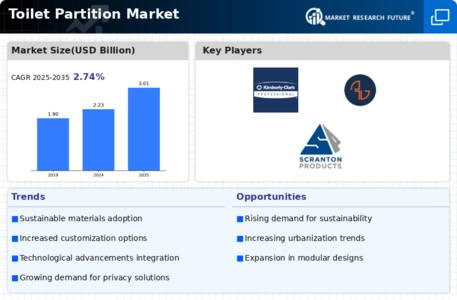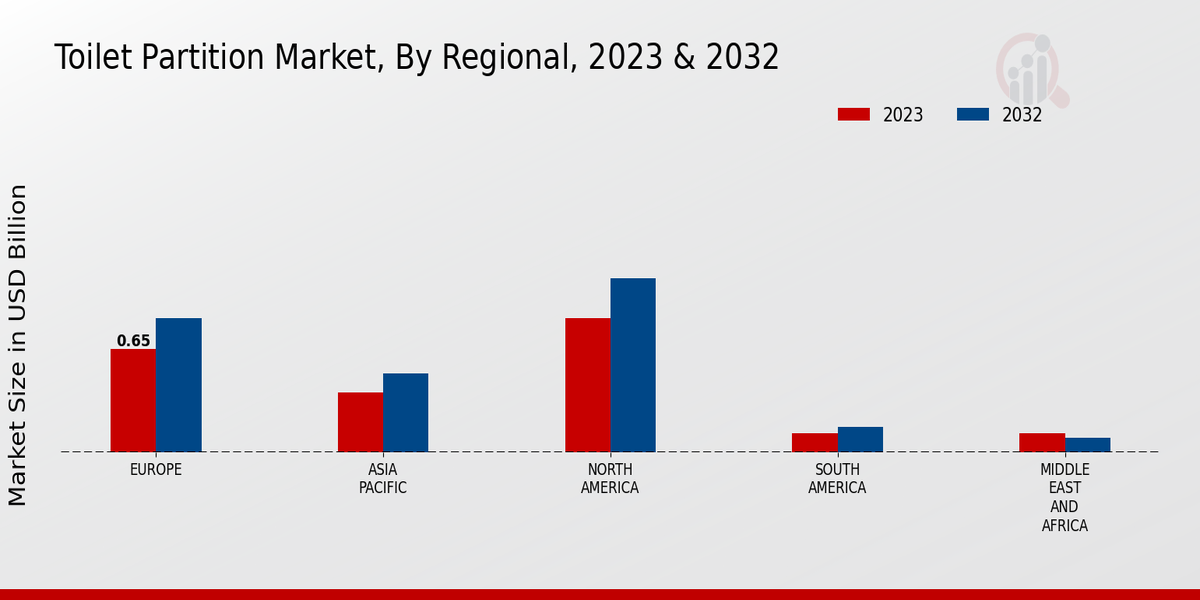Market Growth Projections
The Global Toilet Partition Market Industry is projected to experience steady growth, with an anticipated compound annual growth rate of 2.77% from 2025 to 2035. This growth trajectory suggests a robust demand for toilet partitions across various sectors, driven by factors such as urbanization, increased construction activities, and heightened awareness of hygiene. The market is expected to reach 2.23 USD Billion in 2024, with further expansion anticipated as more businesses and institutions recognize the importance of investing in quality restroom facilities. This positive outlook indicates a favorable environment for manufacturers and suppliers within the industry.
Growth in Construction Activities
The Global Toilet Partition Market Industry benefits from the ongoing growth in construction activities across various sectors, including residential, commercial, and institutional projects. As urban areas expand, the demand for new buildings increases, leading to a higher requirement for restroom facilities equipped with modern toilet partitions. The market is expected to grow to 3.01 USD Billion by 2035, indicating a robust construction pipeline. This growth is particularly pronounced in developing regions, where infrastructure development is a priority. Consequently, manufacturers are focusing on providing versatile and customizable partition solutions that cater to diverse architectural designs and client preferences.
Rising Demand for Hygiene Solutions
The Global Toilet Partition Market Industry experiences a notable surge in demand for hygiene solutions, driven by increasing awareness of sanitation and cleanliness in public spaces. As urbanization accelerates, the need for well-designed restroom facilities becomes paramount. For instance, the market is projected to reach 2.23 USD Billion in 2024, reflecting a growing emphasis on hygiene in commercial and institutional settings. This trend is particularly evident in educational institutions and healthcare facilities, where the implementation of high-quality toilet partitions is essential for maintaining sanitary conditions. Consequently, manufacturers are innovating to provide durable and easy-to-clean materials, aligning with the industry's focus on hygiene.
Government Regulations and Standards
The Global Toilet Partition Market Industry is significantly influenced by stringent government regulations and standards regarding public health and safety. Various countries implement guidelines that mandate the provision of adequate restroom facilities in commercial buildings, schools, and public areas. These regulations often specify the materials and designs that must be used to ensure safety and accessibility. For example, compliance with the Americans with Disabilities Act in the United States necessitates specific design features in toilet partitions. As a result, manufacturers are compelled to adapt their products to meet these evolving standards, thereby driving innovation and growth within the industry.
Sustainability Trends in Material Selection
The Global Toilet Partition Market Industry is increasingly shaped by sustainability trends, as consumers and businesses alike prioritize eco-friendly materials and practices. Manufacturers are responding to this demand by developing toilet partitions made from recycled or sustainable materials, which not only reduce environmental impact but also appeal to environmentally conscious consumers. This shift towards sustainability is likely to enhance brand loyalty and market competitiveness. Furthermore, as regulations around environmental standards tighten, companies that adopt sustainable practices may gain a competitive edge in the market, positioning themselves favorably in the eyes of both consumers and regulatory bodies.
Technological Advancements in Design and Manufacturing
The Global Toilet Partition Market Industry is witnessing a wave of technological advancements that enhance the design and manufacturing processes of toilet partitions. Innovations such as 3D modeling and computer-aided design enable manufacturers to create more efficient and aesthetically pleasing products. Additionally, advancements in materials science have led to the development of partitions that are not only durable but also lightweight and easy to install. These technological improvements are likely to streamline production processes and reduce costs, thereby benefiting both manufacturers and consumers. As the industry evolves, embracing technology will be crucial for maintaining competitiveness and meeting the diverse needs of clients.














